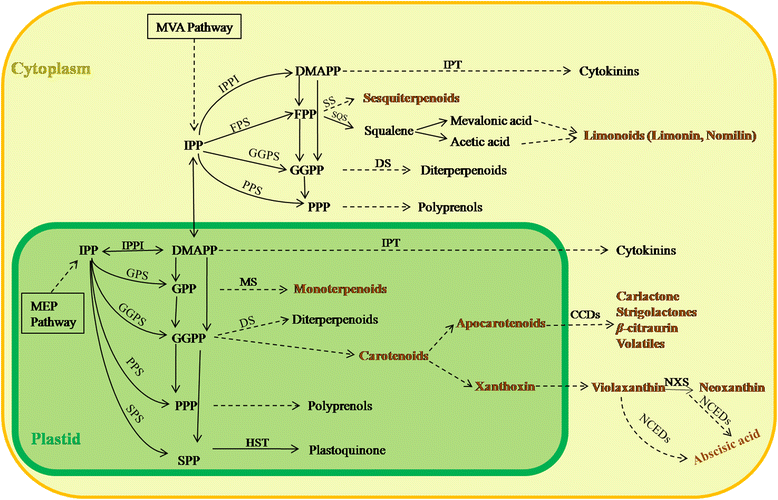Largely different contents of terpenoids in beef red-flesh tangerine and its wild type
- PMID: 28158965
- PMCID: PMC5291992
- DOI: 10.1186/s12870-017-0988-4
Largely different contents of terpenoids in beef red-flesh tangerine and its wild type
Abstract
Background: Niurouhong (Citrus reticulata Blanco. Niurouhong) (NRH) is a spontaneous beef-red flesh mutant with distinctive flavor compared with its wild type orange-red flesh Zhuhongju (ZHJ). To illustrate the biochemical mechanism of its special flesh color and flavor, fruits at commercial mature stage were used to profile the volatiles in the flavedo and determine the levels of carotenoids, limonoid aglycones and phytohormones in the juice sacs in two seasons.
Results: Our results showed the content of total volatile terpenoids in NRH was 1.27-fold that in ZHJ. The components of volatiles were found to be common between the two tangerines. This result indicates that the distinctive flavor of NRH might not be derived from the presence/absence of specific volatiles; instead, it was derived from the altered concentrations or balance of α-citral, β-citral, 2-cyclohexen-1-one, (S)-3-methyl-6-(1-methylethenyl) and n-hexadecanoic acid. Analyses of the contents of total and specific carotenoids indicated that the beef-red color of NRH flesh might be largely attributed to the over accumulation of β-cryptoxanthin and β-carotene. However, lower ABA level was found in NRH than in ZHJ, reflecting a possible feedback regulation of ABA biosynthesis on carotenogenesis and the balance in the metabolism among terpenoids.
Conclusions: Collectively, our study suggested that the MEP pathway was enhanced in NRH tangerine. However, a certain unknown co-regulatory mechanism might be present in the metabolism pathway of secondary metabolites (especially terpenoids) in beef-red flesh mutant. Our study provides new insights into the regulatory network of terpenoid metabolism and mutation mechanism of red-fleshed citrus.
Keywords: Carotenoids; Citrus reticulate Blanco; Limonoid aglycones; Niurouhong; Phytohormone; Terpenoids; Volatile.
Figures



References
-
- Yamamoto K, Yahada A, Sasaki K, Sakamoto K, Ogawa K, Ohta H. Multivariate analyses and characterization of volatile components in citrus species. Food Sci Technol Res. 2013;19(1):39–49. doi: 10.3136/fstr.19.39. - DOI
Publication types
MeSH terms
Substances
LinkOut - more resources
Full Text Sources
Other Literature Sources

